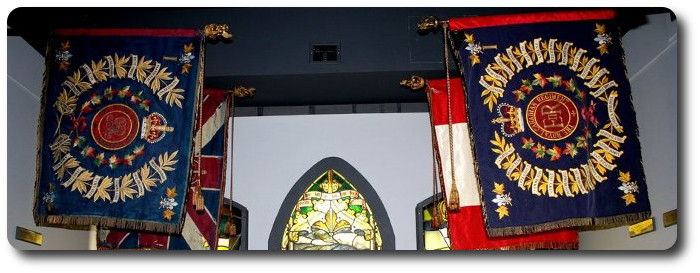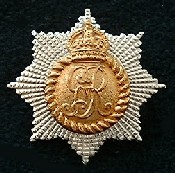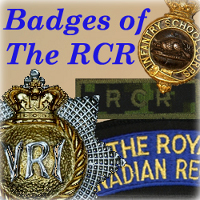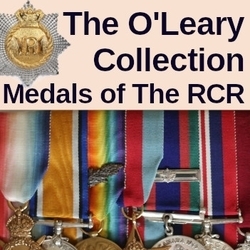
Researching The Royal Canadian Regiment
The Manchester Draft

During the early years of the reign of His Majesty King George V, the official badge (in the eyes of the Militia Department) for The RCR was that ensigned with the King's cypher. The Regiment, however, continued to wear "VRI" badges and to pursue official permission to wear the cypher of Queen Victoria, which was granted in 1919.
The following three articles were published in the regimental journal The Connecting File in 1926 and 1937. They describe how over 150 men and boys of the Manchester Regiment came to serve in The Royal Canadian Regiment.
Twenty Years Ago
The Connecting File, Volume V, No. 4; December 1926
On the 19th November, 1906, there landed at Southampton, from South Africa, about 500 officers, N.C.O.'s and men of the 3rd Bn. Manchester Regiment en route to the 2nd Bn. stationed at The Channel Isles. They were for disbandment under Lord Haldane's new army scheme.
About that time, Colonel Gwatkin, who was employed on the Staff at Ottawa, and was spending some time in England, thought that he would like to secure about 150 N.C.O.'s and men from his old battalion, the 3rd Manchesters whom he had commanded, to volunteer to go out to Canada, and reinforce The Royal Canadian Regiment stationed at Halifax.
Consequently after the usual formalities between the War Office and the Militia Council had been gone through, the Officer commanding the 2nd Bn. The Manchesters called for 150 volunteers.
About 180 responded, but that was too many and they were all assembled in the gymnasium at Fort George and an elimination contest took place which reduced the draft to about 160 all ranks.
They were given five weeks furlough, and were ordered to report at Ashton-under-Lyne barracks, on 7th January, 1907.
They left Liverpool on the S.S. Tunisian on 11th January, and arrived at Halifax, on 21st January, where they were met with the Band and a Guard of Honour from the Royal Canadian Regiment. The Officers accompanying them were Colonel Gwatkin and Lieut. Walkley.
The first impressions of Canada upon the minds of the draft were not very good as the streets of Halifax were covered with ice, and they had great difficulty climbing the hills to Wellington barracks, wearing ammunition boots with the usual hob-nails.
On arrival at Wellington they were soon made to feel as if they were at home and after being posted to their several companies, they were given a substantial meal, and were allowed to roam around barracks to get their bearings.
What a strange sight the Manchesters presented to The R. C. R. at that time with their "Broderick" caps and the broad twang of the Lancashire men.
About 21 men were posted to the band which brought the total to about 70 and many will remember their first parade on guard mounting when the whole battalion turned out to hear them. To-day there on only one man left in the band and he has been "beating it" for 20 years and that is Bandsman Gale. By the way how many of you remember the time when the band played One Officer and one man to church on Brunswick St. (Major Hemming and ex-Pte. Gade).
To the best of my recollections the following are still serving in the Regiment;
London, Ont., with "C" Company and Regt. Headquarters - Serjt. Pushman, Serjt. Stillwell, Cpl. Rigg and Bandsman Gale.
Halifax, N.S., with "A" Company and the Instructional Cadre, S.M.I. Irlam, C.S.M. Woodcock, C.S.M.I. O'Shea, Serjt. Instr. Forse, A/Sjt. O'Keefe. M. D. 7, with the Cadre, S.M.I. B. H. Hawkins.
Some of those in civil life residing in Halifax are Ex - C.S.M. Webb. (Buggy), Pte. Sole, Pte. O'Connors, Pte. Donnelly (the Biffer).
Congratulations to all those who will have completed 20 years' service with The Royal Canadian Regiment on 11th January, 1927.
The Manchester Draft
The Connecting File, Volume XVI, No. 2; April 1937
(Note - The following is re-published from "The Halifax Herald" of the 21st January, 1937, by kind permission of Mr. R. J. Rankin, Managing Editor.)
EXACTLY thirty years ago, January 21, 1907, 157 young soldiers who had transferred from the Manchester Regiment of the Imperial Army, landed at Deepwater to continue their soldiering in the Canadian Permanent Forces, with the R.C.R. They had journeyed from Liverpool, England, on the Tunisian, and arrived in the Harbor on the evening of January 20.
The new Canadian soldiers were met at Deepwater by the band of the R.C.R., who played them to Wellington Barracks. The Draft presented a picturesque sight, all wearing Broderick caps, but the pavement was very slippery, and walking with hobnails on their boots and unaccustomed to icy conditions, the newcomers had a hard job to get to Wellington Barracks, via Cornwallis, Brunswick, North and Gottingen Streets.
There are only a few of the 1907 Manchester Draft in Halifax today. Among those left are ex-Company Serjt.-Major John Woodcock, Sam Street, orderly at Camp Hill Hospital, ex-Band Serjt. W. G. Gibson, W. H. Brocklebank, ex-Q.M.S.I. C. Shea, ex-Serjt. Paddy O'Keefe, Joe James, postal clerk, George Tanner, C. N. R employee, and "Biffer" Donelly.
The Manchester Draft was an acquisition to the R C. R, the majority of the young men who received their early training in the Imperials, gaining promotion. Two of the number, Company Serjt.-Major A. Stillwell and Pte. E. Rigg, are still in the R C. R at London, Ontario, while Q.M.S. Snape is in the Royal Canadian Dragoons, according to old comrades.
Notes on the Manchester Draft
The Connecting File, Volume XVI, No. 2; April 1937
As told to the Editor by Serjeant-Major-Instructor (W.O. I) H. W. Bonner, R.C. Signals
During the latter part of October, 1906, persistent rumours led us to believe that the Manchester Regiment would return to a two-battalion establishment in accordance with a general plan for the Army. Rumours had not, however, prepared us for the startling suddenness with which the change took place.
Our 1st Battalion (63rd Foot) was stationed in India. The 2nd Battalion (96th Foot) was in Guernsey and Alderney; "A" Company, to which I belonged, forming part of the garrison of the latter island. On the 12th November the 4th Battalion arrived in the Channel Islands from Aldershot, followed by the 3rd Battalion from South Africa on the 14th, and from the latter date the Manchesters became a regiment of but two regular battalions. The method of absorbing personnel was simple, the companies of the 3rd and 4th becoming a part of the similarly lettered companies of the 2nd.
Some efforts had been made to reduce our strength by calling for volunteers to extend their service and transfer to the East Lancashire Regiment, a bounty of £10 being offered. Several left. A large draft was likewise sent to the 1st Battalion, whilst others transferred to the Army Reserve under special conditions of decreased colour service with a corresponding increased period with the Reserve. But the third method of making room for the disbanded battalions is the one with which we are concerned.
By an agreement between the British and Canadian Governments, volunteers were requested for the Royal Canadian Regiment, and Lieutenant-Colonel W. G. Gwatkin, a former commanding officer of the 3rd Battalion, and then serving in Canada on loan, arrived in the Channel Islands to select the draft. He gave a lecture, both in Guernsey and Alderney, upon the Permanent Force, and 3-year term of enlistment, no reserve service, and 50 cents a day, were sufficiently attractive inducements to cause 97 of us from the combined "A" Companies to request that our names be considered. Twelve were selected from "A" Company on the 3rd December, and a total of 50 from Alderney. We sailed for Guernsey on the 5th.
Our khaki greatcoats were turned in, and old pattern black coats were issued to us as a parting gift-gifts which were soon to produce a few cents from the Shylocks of Water Street, who added nothing in prices paid for the sentimental worth received.
The draft from Guernsey sailed for England on the 5th December, and we followed them the next day, our instructions being that furlough was granted until the 8th January, 1907, when we must report to our Depot. On the 11th January we embarked at Liverpool on the RM.S. "Tunisian." Lieut. Col. Gwatkin was in command of men of the Manchester Regiment for the last time.
On the 12th January the draft was paraded on the upper deck and each and every man received his discharge from the Manchesters. All were then enlisted for the Royal Canadian Regiment.
On nearing the Canadian coast we ran into cold, rough weather. Ice covered the decks, walking was dangerous, and on one occasion I almost ended my Permanent Force service by sliding into the Atlantic. The ship rolled, the men clutched our mess table, pulled it from its fastenings, and crockery, meals and troops mingled on the deck. A bandsman was hurled against a water-tap, but water-taps sever all connections when brought into violent contact with bandsmen.
At 4.30 p.m., 20th January, 1907, the "Tunisian" docked at Halifax; 156 ex-Manchesters filed through a guard of honour supplied by the R C. R We formed up on Water Street. The band, drums and the guard, about 100 strong, marched off, followed by the draft.
Apparently there had been a snowstorm recently, followed by a thaw on the day of our arrival, and the streets were both slushy and slippery. Our hob-nailed ammunition boots, added to our inexperience in walking under such conditions, resulted in disaster. The band played, the Canadians marched, and we fell ignominiously in our vain efforts to climb the hill of Difficulty, which is known as Cornwallis Street. But how could the others march. Some one solved the problem - "they got blinking spurs on," and this in a sense was true, for "creepers-ice" were an issue in those days.
By determined efforts in crawling and climbing we reached level ground. Our lack of "spurs" became less noticeable, and in some order we proceeded along Gottingen Street. The band struck up the Regimental March, we turned in past the quarter-guard to find a sheet of ice sloping gently away towards the Officers' Mess. The band played on, the guard of honour swung into line, and we fell prostrate before the splendour of all that we saw within the Barracks gates.
Representatives from the six companies met us in this period of our humiliation, and we started off to our several homes. I was the right-hand man of the leading file. On the command "Right wheel-forward" I completed the wheel, being unfamiliar with the word "forward" in this sense. The ice was soft compared to the colour-serjeant's language.
They had kindly prepared for us in Room No. 44, as they had in the other companies. Our beds were made down; knives, forks and spoons were ready for the excellent meal which awaited us on the second corridor; and the final touch of hospitality was added with a generous supply of beer.
We were paid on the 21st January, and I received a $5.00 bill. We knew less about paper money than we did about ice. But although at first it appeared to be "only a scrap of paper," it was very effective paper in Fred Copples' Restaurant-the Coffee Bar of other days.
New uniforms were issued. Oliver equipments were fitted, and last but not least, a Ross Rifle, Mark I, found its way into each man's hands. There followed days under S. M. Dymond, S. M. Brewer, Dr.-Sjt. Paterson, Sjt. Carter, Sjt. McKinney, Sjt. Worthington and Cpl. Bissette, until we finally took our places amongst the trained soldiers of our companies.


